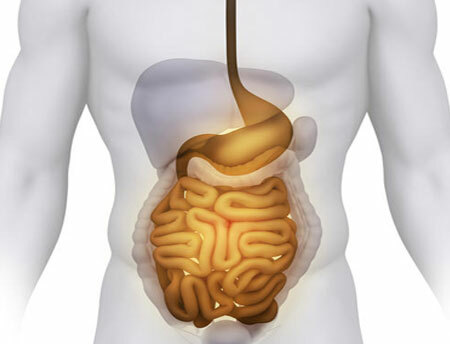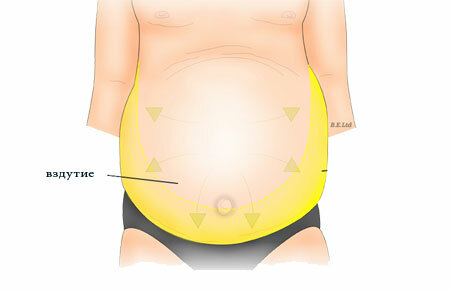Symptoms of malabsorption may disturb the patient with various bowel diseases. Sometimes they are weak and the person complains only of weakness and increased fatigue.
In other cases, this syndrome leads to the development of severe complications - anemia, infertility, cardiac disorders and others. Let us consider in more detail what this pathology is.
Contents
- 1 Malabsorption - what is it?
- 1.1 What happens with malabsorption syndrome?
- 1.2 Forms of malabsorption
- 2 Symptoms of malabsorption
- 2.1 Diagnosis
- 3 Treatment of malabsorption
- 3.1 Forecast
Malabsorption - what is it?
Malabsorption is a clinical symptom-complex that develops due to impaired absorption and transport of nutrients in various parts of the small intestine.

The disease can be congenital or develop due to various pathological conditions of the intestine.
Key causes of intestinal malabsorption:
1. Congenital diseases, occurring in 7-10% of cases. These include:
- Celiac disease. Disturbance of digestion, in which the villi of the small intestine is damaged by food products containing gluten( rye, barley, etc.);
- Cystic fibrosis. Hereditary disease with primary respiratory damage. In addition, it causes the development of inflammatory processes in the pancreas, liver and atrophy of the intestinal mucosa;
- Glucose-galactose malabsorption. Hereditary pathology, in which the transport of monosaccharides in the intestinal wall is disrupted due to the mutation of the carrier protein;
- Cystinuria. Genetic disease with a violation of transport of cystine.
Hartnup disease. Hereditary disorder of transport of tryptophan and other amino acids in the intestine and others.
2. Purchased. There are many more. Violation of absorption and transport of substances can be a consequence of inflammatory bowel diseases, postoperative interventions in this area, oncology and other pathological processes.
What happens with malabsorption syndrome?
The absorption process mainly occurs in the small intestine. This process takes place in several stages:
- First of all, the incoming proteins, fats and carbohydrates are cleaved under the influence of enzymes to the final products( monosaccharides, glycerol, fatty acids, amino acids).
- The mucosa of the small intestine is covered with numerous microvilli, which are capable of sucking and digesting these end products. After that they enter the bloodstream and enter the liver through the portal vein system.
- Some nutrients( fats) from villi immediately enter the lymph and then into the chest lymphatic duct.
Disorders at any of these levels( lack of enzymes, damage to villi, etc.) leads to the development of malabsorption syndrome of the small intestine. The mucous membrane can not transport all or separate nutrients into the blood or lymph, they accumulate in the lumen of the intestine, and the patient's body suffers from their lack, which manifests itself as characteristic symptoms.
Forms of malabsorption
Depending on the cause of this pathology is divided into congenital and acquired. The syndrome of malabsorption in children is usually congenital, whereas in adults it is the result of acquired intestinal diseases.
In addition, there are several degrees of severity of the disease:
- 1st. The patient's body weight is reduced slightly( up to 5-7 kg).There are signs of general weakness and increased fatigue, some symptoms of beriberi;
- 2nd. Decreased body weight by more than 10-12 kg. The symptoms of avitaminosis are expressed, the sexual and reproductive function suffers;
- 3rd. Expressed deficiency of body weight, severe anemia, beriberi, edema, signs of multiple organ failure.
Important! The critical body mass deficit in each patient is individual. For one, loss and 13 kg is not a problem, and in another, a weight loss of 10 kg can lead to serious disorders.
Symptoms of malabsorption

The disease occurs with a variety of manifestations. Let us dwell on the main symptoms of malabsorption:
- Weight reduction. Due to problems with absorption, the patient's body weight begins to fall. This is due to a lack of nutritional components in the body. In young children, there may be a development gap. Deficiency of body weight can be mild, moderate and severe severity.
- Problems with stool. Patients are concerned about frequent and prolonged diarrhea with an unpleasant odor. The color and consistency of stools depend on the absorption of which substances was disturbed. So, with problems with the transport of bile acids, the feces become colorless. In addition, it can be mixed with fat, light and shiny( steatorrhea).
- General malaise. Nonspecific signs of the disease, such as weakness, lethargy, apathy, decreased efficiency, fatigue, etc.
- External deterioration of the quality of the skin and its appendages( hair, nails).Due to deficiency of vitamins and nutrients, the skin and hair become dull, the nails become brittle, inflammatory changes on the mucous membranes develop.
- Edema. As a result of a lack of protein in the body, peripheral edema develops, which are located in the area of the ankles. In severe cases, ascites may be observed( dropsy of the abdomen).
- Signs of vitamin deficiency. Vitamin deficiency is accompanied by various signs: subcutaneous hemorrhage appears, vision is impaired( vitamin A deficiency is "night blindness"), sensitivity changes, pale skin turns out, teeth fall out, bleeds gums, etc.
- Disturbance of mineral metabolism, which is manifested by pains in muscles and joints, malfunctioning of the heart, osteoporosis and other disorders.
- Hormonal imbalance. In patients, a disorder of the thyroid gland function is noted, sexual activity decreases. With severe disorders, all the endocrine glands in the body are affected.
Symptomatics and clinical picture depend on the underlying cause of the disease, the degree of malabsorption, and the lack of which substances is particularly pronounced.
Diagnostics
For diagnosis it is required to establish the cause, which leads to the appearance of this syndrome. The patient is clarified anamnesis, they are asked about the transferred diseases and surgical interventions on the intestine.
Stool analysis helps to identify the presence of steatorrhea( fat in the feces) and to suggest disorders of fat metabolism. Diagnostic search is based on the study of the work of the intestine, liver and pancreas. For this, the patient is prescribed ultrasound, x-ray, MRI, biochemical blood test and other studies depending on the alleged diagnosis.
Treatment of malabsorption

Treatment of malabsorption syndrome is carried out taking into account the established cause of the disease. Therapy is aimed not only at the very cause, but also in the elimination of body mass deficit, malabsorption symptoms and prevention of possible complications.
Treatment is conducted in several directions:
1. Diet. Given the high protein loss, a high-protein diet with a minimum amount of fat is prescribed. Such patients are selected special mixtures and products in which all nutrients are balanced and taken into account.
If necessary, these mixtures are injected through the probe directly into the stomach. Heavy and weak patients can temporarily switch to parenteral nutrition( the supply of nutrients through the blood).
2. Drug therapy. It includes:
- antidiarrheal drugs;
- replacing hormone therapy;
- correction of deficiency of vitamins and minerals;
- enzymes and bile acids;
- medications that improve intestinal trophism;
- antibiotics for the prevention and treatment of infectious complications.
3. surgery is indicated in patients with Crohn's disease, malignant neoplasms, complications of ulcerative colitis and liver pathology.
Forecast
The prognosis of malabsorption is determined by the cause of its development and the time of initiation of treatment. In some cases, it is enough for patients to follow the principles of dietary therapy, so that the illness stops reminding oneself. So, with acute inflammation of the intestinal mucosa, this syndrome can disappear within a week after the beginning of adequate treatment.
In other cases, even drug therapy is not enough, and patients die at a young age from exhaustion and multiple organ failure. With a severe degree, the five-year survival rate in such patients is about 65-70%.
Preventative measures depend on which disease caused the syndrome.



